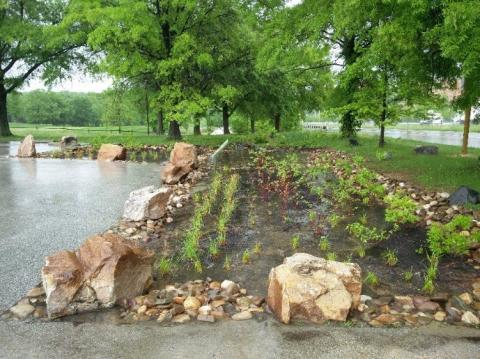Stormwater Management on Campus

Stormwater management is the effort to mitigate the impact of rainwater runoff from impervious surfaces such as parking lots, streets, and lawns. Rainwater and snowmelt runoff can carry harmful pollutants and nutrients that end up in our waterways decreasing water quality and biodiversity. College Park is located in the Anacostia Watershed and our stormwater discharges into three tributaries. In order to reduce adverse impacts we instill Best Management Practices (BMPs) on campus which are practices that are most effective & efficient in reducing pollution from nonpoint sources. At the University of Maryland, our goals are to meet all stormwater regulations and permits, identify future improvement opportunities, and research ways we can reuse stormwater as means to cut down consumption of potable water.
UMD has obtained three stormwater permits as means to regulate runoff. The first permit is the Individual Industrial Permit which authorizes the discharge of wastewater through a separate storm drain system. The 20-SW permit regulates stormwater management in six different locations on campus. Lastly, the NPDES Municipal Separate Storm Sewer System (MS4) Phase II General Permit covers the discharge of all stormwater runoff which flows into our campus drain system.
These three permits require UMD to meet specific requirements and employ Best Management Practices. Strategies utilized include regular site inspections and sampling the 13 permitted sources to ensure pollutants are below maximum levels. Illicit Discharge Detection and Elimination is also employed to identify and modify unallowable discharges. There are over 100 stormwater control facilities that are inspected and maintained on campus. We are also currently performing GIS mapping to further pinpoint impermeable areas and identify possible future stormwater projects.
Many stormwater management strategies have already been implemented on campus. Green roofs absorb rainwater on rooftops reducing the amount of runoff and impermeable surfaces on campus at seven locations including ESJ and the Physical Complex Building. Porous pavements allow for the penetration of water through the ground which reduces runoff at five locations on campus. Rain gardens, also known as bioretention cells, are engineered with plants to collect, hold, and clean rainwater that runs off of impervious surfaces. Some rain gardens are known as Low Impact Development projects which filter runoff before the polluted stormwater can enter the Campus Creek. UMD also participates in rainwater harvesting which redirects runoff to be used for other purposes. In Washington Quad, rainwater harvesting directs the water into a drip irrigation system which aids in watering nearby plants. UMD has also restored Campus Creek. Stormwater runoff was mitigated by planting native species, creating step pools to slow runoff, and creating floodplains which draw in more native plants and animals. UMD’s future project includes the creation of the Agroecology Corridor which would encourage students and faculty to have important conversations surrounding environmental issues.
